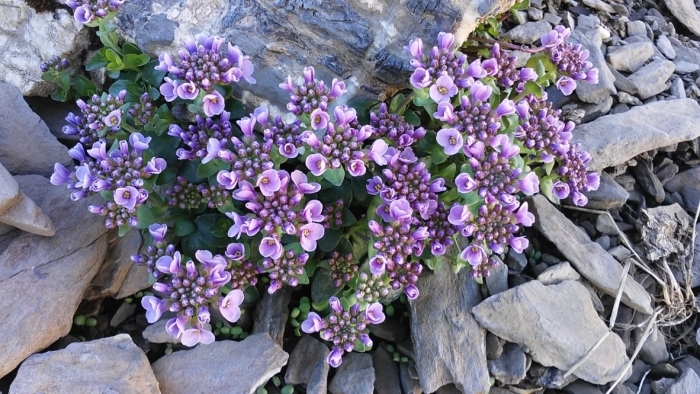Round-Leaved Pennycress
(Noccaea rotundifolia)
Round-Leaved Pennycress (Noccaea rotundifolia)
/
/

Guillaume Delaitre
CC BY 4.0
Image By:
Guillaume Delaitre
Recorded By:
Copyright:
CC BY 4.0
Copyright Notice:
Photo by: Guillaume Delaitre | License Type: CC BY 4.0 | License URL: http://creativecommons.org/licenses/by/4.0/ | Rights Holder: Guillaume Delaitre | Publisher: iNaturalist | Date Created: 42897 |
























Estimated Native Range
Summary
Noccaea rotundifolia, commonly known as Round-leaved Pennycress, is a hardy annual herb native to alpine and subalpine zones in Europe, including the Pyrenees, Alps, and Carpathians. It is adapted to survive in harsh, cold environments, such as arctic conditions and high mountain habitats. This plant typically grows to a height of 10-30 cm and forms a basal rosette of leaves with short, unbranched stems that culminate in dense racemes of small, showy pink flowers that bloom in late spring to early summer.
Round-leaved Pennycress is valued for its ability to thrive in rocky, well-drained soils and its low maintenance requirements, making it an excellent choice for rock gardens and alpine collections. It prefers full sun to partial shade and requires moderate water, particularly in well-drained, loamy or sandy soils. While it is not commonly used in large-scale cultivation, its resilience and attractive flowers make it a charming addition to specialized garden settings. Its small stature and flowering habit also make it suitable for container gardening. Potential problems include susceptibility to common pests and diseases that affect Brassicaceae family members, such as flea beetles and downy mildew.CC BY-SA 4.0
Round-leaved Pennycress is valued for its ability to thrive in rocky, well-drained soils and its low maintenance requirements, making it an excellent choice for rock gardens and alpine collections. It prefers full sun to partial shade and requires moderate water, particularly in well-drained, loamy or sandy soils. While it is not commonly used in large-scale cultivation, its resilience and attractive flowers make it a charming addition to specialized garden settings. Its small stature and flowering habit also make it suitable for container gardening. Potential problems include susceptibility to common pests and diseases that affect Brassicaceae family members, such as flea beetles and downy mildew.CC BY-SA 4.0
Plant Description
- Plant Type: Herb
- Height: 0.1-0.3 feet
- Width: 0.5-1 feet
- Growth Rate: Moderate
- Flower Color: Pink
- Flowering Season: Spring
- Leaf Retention: Evergreen
Growth Requirements
- Sun: Full Sun, Part Shade
- Water: Medium
- Drainage: Fast
Common Uses
Low Maintenance, Rock Garden
Natural Habitat
Alpine and subalpine zones in Europe
Other Names
Common Names:
Scientific Names: , Noccaea rotundifolia, Crucifera rotundifolia, Hutchinsia rotundifolia, Hutchinsia rotundifolia, Iberidella rotundifolia, Iberis repens, Iberis rotundifolia, Lepidium rotundifolium, Lepidium rotundifolium
GBIF Accepted Name: